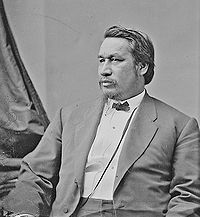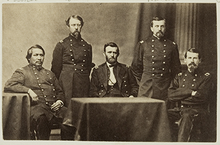- Ely S. Parker
-
Ely Samuel Parker 
Ely ParkerBorn 1828
Indian Falls, New YorkDied August 31, 1895 (aged 66–67)
Fairfield, ConnecticutPlace of burial Forest Lawn Cemetery Buffalo, New York Allegiance United States of America Years of service June 4, 1863 - April 26, 1869[1] Rank Brevet Brigadier General Unit Western Theater
Adjutant to General GrantBattles/wars Other work Head of the Bureau of Indian Affairs Ely Samuel Parker (1828 – August 31, 1895), (born Hasanoanda, later known as Donehogawa) was a Seneca attorney, engineer, and tribal diplomat. He was commissioned a lieutenant colonel during the American Civil War, when he served as adjutant to General Ulysses S. Grant. He wrote the final draft of the Confederate surrender terms at Appomattox. Later in his career, Parker rose to the rank of Brevet Brigadier General. President Grant appointed him as Commissioner of Indian Affairs, the first Native American to hold that post.[1]
Contents
Early life and education
Ely Parker was born in 1828 as the sixth of seven children to William and Elizabeth Parker, of prominent Seneca families, at Indian Falls, New York (then part of the Tonawanda Reservation).[2] His father was a miller and a Baptist minister.[3] The Seneca were one of the Six Nations of the Haudenosaunee (Iroquois Confederacy). Ely had a classical education at a missionary school, was fully bilingual, and went on to college. He spent his life bridging his identities as Seneca and a resident of the United States.
The parents strongly supported education for all the children, who included Spencer Houghton Cone, Nicholson Henry, Levi, Caroline (Carrie), Newton, and Solomon.[3] Nicholson Parker also became a prominent Seneca leader as he was a powerful orator. Beginning in the 1840s, the Parker home became a meeting place of non-Indian scholars who were interested in the people, such as Lewis Henry Morgan, Henry Rowe Schoolcraft and John Wesley Powell; they were connected to the discussions and studies that formed anthropology as a discipline.[3]
Parker worked in a legal firm reading law for the customary three years in Ellicottville, New York and then applied to take the bar examination. He was not permitted because, as a Seneca, he was not considered a United States citizen at that time.[4] It was not until 1924 that all American Indians were considered citizens under the Indian Citizenship Act of 1924.[5] Brown's Bury My Heart at Wounded Knee stated Parker was refused because he was not a white man.[6]
In the late 1840s, Parker met Lewis Henry Morgan at his parents' home. Morgan was an independent scholar who was studying the kinship structure and culture of the Iroquois. Parker became Morgan's main source of information and entrée to others in the Seneca and other Iroquois nations. Morgan dedicated his book on the Iroquois to Parker, noting their joint collaboration on the project.
With Morgan's help, Parker gained admission to study engineering at Rensselaer Polytechnic Institute in Troy, New York. He worked as a civil engineer until the start of the American Civil War.
Marriage and family
Parker married Minnie Orton Sackett (1849–1932) in 1867. They had one daughter, Maud Theresa (1878–1956).[7]
Career
Parker began his career in public service by working as an interpreter and diplomat to the Seneca chiefs in their negotiations about land and treaty rights, in 1852 Parker was made sachem of the Seneca, the nation known as the Donehogawa, Keeper of the Western Door.
Before this he had met and worked with Morgan, an independent scholar in the field of ethnology and anthropology. Morgan dedicated his book League of the Iroquois (1851) to Parker, with "the materials are the fruit of our joint researches." Morgan also helped Parker gain entry to Rensselaer Polytechnic, because he recognized the man's abilities.[8]
As an engineer, Parker contributed to upgrades and maintenance of the Erie Canal, among other projects. As a supervisor of government projects in Galena, Illinois, he first met and befriended Ulysses S. Grant. Their strong collegial relationship was useful later.[8]
Civil War service
Near the start of the Civil War, Parker tried to raise a regiment of Iroquois volunteers to fight for the Union, but was turned down by New York Governor Edwin D. Morgan. He then sought to join the Union Army as an engineer, but was told by Secretary of War Simon Cameron that as an Indian, he could not join.[9] Parker contacted his colleague and friend Ulysses S. Grant, who intervened. His forces suffered from a shortage of engineers, and Parker was commissioned a captain in May, 1863 and ordered to report to Brig. Gen. John Eugene Smith. General Smith appointed Parker as the chief engineer of his 7th Division during the siege of Vicksburg. Smith said Parker was a "good engineer".
When Ulysses S. Grant became commander of the Military Division of the Mississippi, Parker became his adjutant during the Chattanooga Campaign. He was subsequently transferred with Grant as the adjutant of the U.S. Army headquarters and served Grant through the Overland Campaign and the Siege of Petersburg. At Petersburg, Parker was appointed as the military secretary to Grant, with the rank of lieutenant colonel. He wrote much of Grant's correspondence.
Parker was present when Confederate general Robert E. Lee surrendered at Appomattox Courthouse in April 1865. He helped draft the surrender documents, which are in his handwriting. At the time of surrender, General Lee mistook Parker for a black man, but apologized saying, "I am glad to see one real American here." Parker was said to respond, "We are all Americans, sir." Parker was brevetted brigadier general of volunteers on April 9, 1865.
Post-Civil War
After the Civil War, Parker was commissioned as an officer in the 2nd United States Cavalry on July 1, 1866. He again became the military secretary to Grant as he finished out his time as general in chief. Parker resigned from the army with the brevet rank of brigadier general of Regulars on April 26, 1869.[1]
Grant appointed Parker as Commissioner of Indian Affairs from 1869 to 1871. He was the first Native American to hold the office. Parker became the chief architect of President Grant's Peace Policy in relation to the Native Americans in the West. Under his leadership, the number of military actions against Indians were reduced in the west.
After leaving government service, Parker invested in the stock market. At first he did well, but eventually lost the fortune he had accumulated, after the collapse of 1873. Through his social connections, Parker received an appointment to the Board of Commissioners of the New York Police Department's Committee on Supplies and Repairs. Parker received many visits at Police Headquarters on Mulberry Street from Jacob Riis, the photographer famous for documenting the lives of slum dwellers, who enjoyed "smoking a pipe in his poky little office" and was "famous for his access to internal police reports."[10] Parker is featured as a character in a short story by Riis, "A Dream of the Woods," about a Mohawk woman and her child stranded in Grand Central Terminal.[10]
Parker lived his last years in poverty, dying in Fairfield, Connecticut on August 31, 1895, where he was buried. The Seneca did not feel Algonquin territory was appropriate for a final resting place, and requested that his widow relocate the grave.[10] On January 20, 1897, his body was exhumed and moved to Forest Lawn Cemetery in Buffalo, New York. He was reinterred next to his ancestor Red Jacket, a famous Seneca orator, and other notables of western New York.
Legacy and honors
- Parker's career and impact on contemporary Native Americans is described in Chapter 8 of Dee Brown's Bury My Heart at Wounded Knee.
- He is said to have helped found the town of Parker, Arizona. Another individual with the surname of Parker is credited with this distinction as well.
See also
- Fellows v. Blacksmith
Notes
- ^ a b c Parker, Arthur (1919). The Life of General Ely S. Parker. Buffalo Historical Society. pp. 154. http://books.google.com/books?id=Chg8AAAAIAAJ&printsec=titlepage&dq=The+Life+of+General+Ely+S.+Parker,+by+Arthur+Parker&cad=0. (reprinted 2005, ISBN 1-889246-50-6)
- ^ "Biography of Ely Samuel Parker", The Newberry Library
- ^ a b c Joy Porter, To Be Indian: The Life of Iroquois-Seneca Arthur Caswell Parker, University of Oklahoma Press, 2001, pp. 1825-1827, accessed 17 February 2011
- ^ Gerry J. Gilmore, "Seneca Chief Fought Greed, Injustice", American Forces Press Service
- ^ The Indian Citizenship Act (1924) (43 Stat. 253, ante, 420)
- ^ Dee Brown , Bury My Heart at Wounded Knee. 1970. ISBN 0-330-23219-3
- ^ Hoxie, Frederick E. (1996). Encyclopedia of North American Indians. Houghton Mifflin Company. p. 467. ISBN 0-395-66921-9.
- ^ a b Steven Conn, History's Shadow: Native Americans and Historical Consciousness in the Nineteenth Century, Chicago: University of Chicago Press, 2004, p.210
- ^ Parker, Arthur (1919). The Life of General Ely S. Parker. Buffalo Historical Society. pp. 102–3. http://books.google.com/books?id=Chg8AAAAIAAJ&printsec=titlepage&dq=The+Life+of+General+Ely+S.+Parker,+by+Arthur+Parker&cad=0. (reprinted 2005, ISBN 1-889246-50-6)
- ^ a b c Adams, James Ring (Fall 2011), "The Many Careers of Ely Parker", National Museum of the American Indian: 30–31
References
- Armstrong, William H. (1978) Warrior in Two Camps. Syracuse University Press. ISBN 0-8156-0143-3.
External links
 Media related to Ely Parker at Wikimedia CommonsCategories:
Media related to Ely Parker at Wikimedia CommonsCategories:- 1828 births
- 1895 deaths
- Burials at Forest Lawn Cemetery, Buffalo
- Native American United States military personnel
- Native American politicians
- Native Americans in the Civil War
- People from Genesee County, New York
- People of New York in the American Civil War
- Rensselaer Polytechnic Institute alumni
- Seneca people
- Union Army officers
Wikimedia Foundation. 2010.

